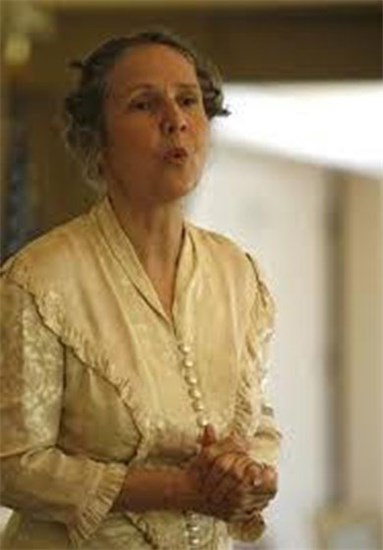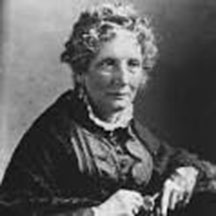

Harriet Beecher Stowe (1811-1896)
by Nan Colton
Sponsored by High Plains Library District
Essay
Harriet Beecher Stowe published more than 25 books in her lifetime, but it was her best-selling anti-slavery novel Uncle Tom's Cabin, an allegorical abolitionist novel, that is often credited with shifting public opinion regarding slavery, which led to the Civil War. It catapulted her to international celebrity and secured her place in history. When Abraham Lincoln met Beecher Stowe in 1962, he allegedly told her, “So you are the little woman who wrote the book that created this great war.” Stowe's passion for writing allowed her to publicly express her thoughts and beliefs in a time when a woman could not speak publicly, much less vote or hold public office.
Harriet was the seventh of 13 children born to outspoken Calvinist preacher Lyman Beecher and Roxana (Foote), a deeply religious woman who died when Stowe was only five years old.
In 1836 Harriet married Calvin Stowe, a widower who was a professor at the Lane Theological Seminary. He was an ardent critic of slavery, and the Stowes supported the Underground Railroad, temporarily housing several fugitive slaves in their home. As a young wife living in Cincinnati, Harriet and Calvin had seven children together, including twin daughters.
At the age of forty, the first installment of Uncle Tom's Cabin appeared on June 5, 1851 in the anti-slavery newspaper, The National Era. Stowe’s writing drew on her personal experience: she was familiar with slavery, the antislavery movement, and the Underground Railroad. She originally used the subtitle “The Man That Was A Thing”, but it was soon changed to “Life Among the Lowly.” In 1852 the serial was published as a two-volume book, now titled Uncle Tom’s Cabin and Harriet suddenly became a celebrity, speaking against slavery both in America and Europe. She wrote A Key to Uncle Tom's Cabin (1853) extensively documenting the realities on which the book was based, to refute critics who tried to argue that it was inauthentic; and published a second anti-slavery novel, Dred in1856.
Uncle Tom's Cabin was a runaway best-seller, selling 10,000 copies in the United States in its first week and not only did it bring her financial security, it enabled Harriet to write full time. It has been translated into over 60 languages and resonates with an international audience as a protest novel and literary work.
Harriet’s writing career spanned 51 years, during which time she published 30 books and countless short stories, poems, articles, three travel memoirs, children's text books, advice books on homemaking and childrearing, biographies, religious studies and hymns. Her work is admittedly uneven. The historical significance of Stowe's antislavery writing has tended to draw attention away from her other writings, and from her literary significance. Harriet Beecher Stowe was influential both for her writings and her public lectures on social issues of the day. She believed her actions could make a positive difference. Her words changed the world; her bravery − as she picked up her pen – inspires us to believe in our own ability to effect positive change
Recommended Reading
King, Wilma. Stolen Childhood: Slave Youth in Nineteenth-century America. Indiana University Press, 1995.
Stowe, Harriet Beecher, and Elizabeth Ammons. Uncle Tom's Cabin: Authoritative Text, Backgrounds and Contexts, Criticism. W.W. Norton, 1994.
Stowe, Harriet Beecher, and Joan D. Hedrick. The Oxford Harriet Beecher Stowe Reader. Oxford University Press, 1999.
Wilson, Robert Forrest. Crusader in Crinoline: The Life of Harriet Beecher Stowe. J.B. Lippincott, 1941.
Nan Colton
Nan Colton is a produced playwright, director, storyteller, actress and performing teaching artist having performed and lectured professionally on a wide variety of stages throughout South Africa, Great Britain and the United States.
Nan’s entrepreneurial spirit led to her creation of Solo Productions in 1995, and she has committed her talents to create and present theatrical solo performances and workshops that are interactive, educative, historically accurate and entertaining in museums, art galleries, schools, universities and at conferences mainly in Florida.
For the past 19 years, Nan has served as the Performing-Artist-in-Residence at the Museum of Fine Arts, St. Petersburg, having researched, produced, written and presented over 39 vastly different original scripts (historically accurate or humorously fictitious) characters written to explain the art and the exhibitions.
Another side of her work: Nan is currently contracted as a cultural and educational programming coordinator for the Quak Center for Lifelong Learning, Westminster Suncoast retirement community, St. Petersburg. Her focus is the reality that learning need never stop.
“There’s truth is the saying: A picture is worth a thousand words. But it doesn’t stop me from talking about Art and Beauty.” – Literary and Performing Teaching Artist statement.
Bullet Points
-
Stowe’s passion for writing allowed her to publicly express her thoughts and beliefs in a time when a woman could not speak publicly, much less vote or hold public office. Stowe's words changed the world: her bravery as she picked up her pen inspires us to believe in our own ability to effect positive change.
-
Uncle Tom's Cabin struck a nerve and found a permanent place in American culture. Translated into more than sixty languages, it is known throughout the world. After a century and a half this classic anti-slavery novel remains an engaging and powerful work, read in college and high school courses dealing with literature, history, and issues of race and gender.
-
Uncle Tom's Cabin, with its compelling story, challenges us to confront America's complicated past and connect it to today's issues.
Quotes
“When you get into a tight place and everything goes against you, till it seems as though you could not hang on a minute longer, never give up then, for it is just the place and time that the tide will turn.’ -- Harriet Beecher Stowe
“So much has been said and sung of beautiful young girls, why doesn't somebody wake up to the beauty of old women?”-- Harriet Beecher Stowe
“So you are the little woman who wrote the book that created this great war.”—Abraham Lincoln to Harriet Beecher Stowe
Timeline
1811
Harriet Elisabeth Beecher (Harriet Beecher Stowe), daughter of Lyman Beecher and Roxanna Foote, is born in Litchfield, Connecticut, June 14.
1816
Roxanna Foote Beecher, Stowe’s mother, dies in September.
1824- 31
Harriet Beecher studies and teaches at the Hartford Female Seminary, the school founded by her sisters Catharine and Mary under Catharine’s leadership.
1833
The book Primary Geography for Children, on an Improved Plan, written by Stowe and credited to her sister Catherine, is published. After several printings, Harriet Beecher is accorded recognition as a coauthor.
1836
Harriet Beecher and Calvin Ellis Stowe marry in January.
1850
The Stowe family moves to Brunswick, Maine, where Calvin is appointed to the faculty of Bowdoin College. Stowe moves first with the children, then Calvin follows. The Fugitive Slave Act passes. Stowe is urged to write against slavery by her sister-in-law.
1851- 52
Uncle Tom’s Cabin: or Life Among the Lowly, appears as a serial in the abolitionist newspaper The National Era, June 5, 1851 though April 1, 1852.
1852
Uncle Tom’s Cabin is published in book form March 20. Over 300,000 copies are sold in the first year.
1862
Stowe met with Abraham Lincoln at the White House.
1889
The Life of Harriet Beecher Stowe Compiled from Her Letters and Journals by Charles Stowe, her son, is published. This is an authorized version and is overseen by his mother.
1896
Harriet Beecher Stowe dies on July 1.